Q1: In the DC-DC converter shown in the figure, the current through the inductor is continuous, The switching frequency is 500 Hz. The voltage (V0) across the load is assumed to be constant and ripple free. The peak inductor current in amperes is ______(rounded off to the nearest integer). (2024)
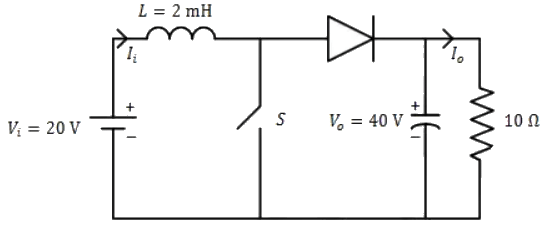 (a) 11
(a) 11
(b) 13
(c) 15
(d) 18
Ans: (b)
Sol: 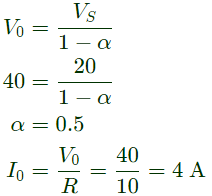 Boost :
Boost :

Q2: A single-phase full bridge voltage source inverter (VSI) feeds a purely inductive load. The inverter output voltage is a square wave in 180° conduction mode. The fundamental frequency of the output voltage is 50 Hz. If the DC input voltage of the inverter is 100 V and the value of the load inductance is 20mH, the peak-to-peak load current in amperes is ______ (rounded off to the nearest integer). (2024)
(a) 35
(b) 45
(c) 50
(d) 55
Ans: (c)
Sol: 
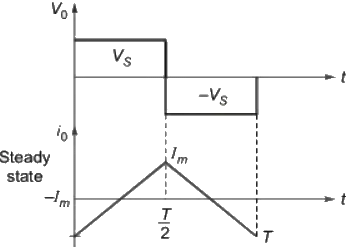




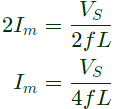 ∴ Peak to peak load current,
∴ Peak to peak load current,

Q3: A single-phase half-controlled bridge converter supplies an inductive load with ripple free load current. The triggering angle of the converter is 60°. The ratio of the rms value of the fundamental component of the input current to the rms value of the total input current of the bridge is ______ (rounded off to 3 decimal places). (2024)
(a) 0.125
(b) 0.365
(c) 0.811
(d) 0.955
Ans: (d)
Sol: 1 − ϕ Half controlled bridge rectifier
α = 60°

 Alternate solution:
Alternate solution:
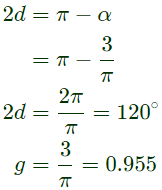
Q4: A 3-phase grid-connected voltage source converter with DC link voltage of 1000 V is switched using sinusoidal Pulse Width Modulation (PWM) technique. If the grid phase current is 10 A and the 3-phase complex power supplied by the converter is given by (−4000 − j3000)V A, then the modulation index used in sinusoidal PWM is ___________. (round off to two decimal places) (2022)
(a) 0.23
(b) 0.47
(c) 0.64
(d) 0.87
Ans: (b)
Sol: Apparent power, S = (-4000 - j3000) VA
 Put the values
Put the values

Q5: Consider an ideal full-bridge single-phase DC-AC inverter with a DC bus voltage magnitude of 1000 V. The inverter output voltage v(t) shown below, is obtained when diagonal switches of the inverter are switched with 50 % duty cycle. The inverter feeds a load with a sinusoidal current given by, i(t) = 10sin(ωt−(π/3))A, where ω = (2π/T). The active power, in watts, delivered to the load is _________. (round off to nearest integer) (2022)
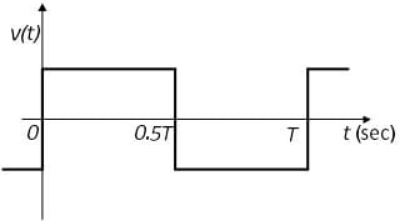 (a) 2154
(a) 2154
(b) 3254
(c) 3181
(d) 4578
Ans: (c)
Sol: For 1 − ϕ invertor, RMS value of fundamental component
 Now, Power output
Now, Power output

Q6: A single-phase full-bridge inverter fed by a 325 V DC produces a symmetric quasi-square waveform across 'ab' as shown. To achieve a modulation index of 0.8, the angle θ expressed in degrees should be _______. (Round off to 2 decimal places.)
(Modulation index is defined as the ratio of the peak of the fundamental component of Vab to the applied DC value.) (2021)
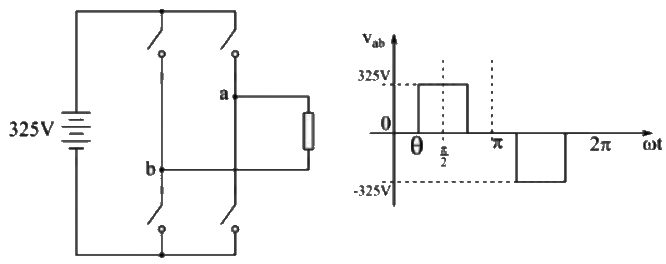 (a) 51.1
(a) 51.1
(b) 28.06
(c) 58.3
(d)69.24
Ans: (a)
Sol: 

 ∴
∴ 
Q7: The output voltage of a single-phase full bridge voltage source inverter is controlled by unipolar PWM with one pulse per half cycle. For the fundamental rms component of output voltageto be 75% of DC voltage, the required pulse width in degrees (round off up to one decimal place) is _________ (2019)
(a) 82.6
(b) 98.6
(c) 112.8
(d) 168.2
Ans: (c)
Sol: 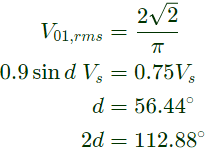

Q8: The figure below shows a half-bridge voltage source inverter supplying an RL-load with R = 40Ω and L = (0.3/π)H. The desired fundamental frequency of the load voltage is 50 Hz. The switch control signals of the converter are generated using sinusoidal pulse width modulation with modulation index. M = 0.6. At 50 Hz, the RL-load draws an active power of 1.44 kW. The value of DC source voltage VDC in volts is (SET-2 (2017))
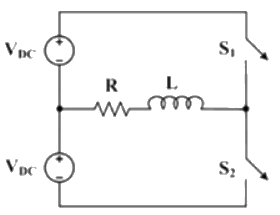 (a) 300√2
(a) 300√2
(b) 500
(c) 500√2
(d) 1000√2
Ans: (c)
Sol: 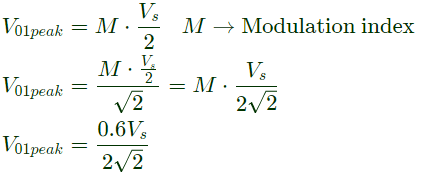
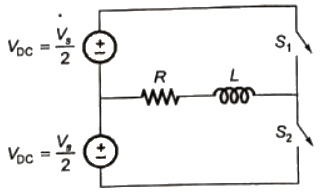

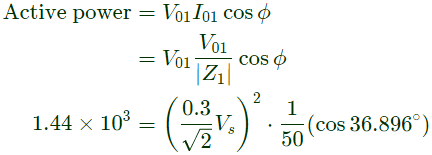

Q9: A three-phase voltage source inverter with ideal devices operating in 180° conduction mode is feeding a balanced star-connected resistive load. The DC voltage input is Vdc. The peak of the fundamental component of the phase voltage is (SET-2(2017))
(a) Vdc/π
(b) 2Vdc/π
(c) 3Vdc/π
(d) 4Vdc/π
Ans: (b)
Sol: 3 − ϕ VSI 180° mode:
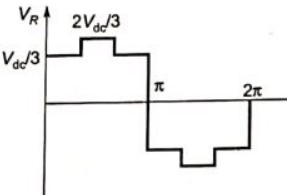
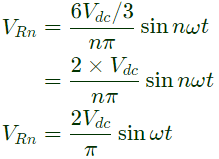
Q10: In the converter circuit shown below, the switches are controlled such that the load voltage vo(t) is a 400 Hz square wave. The RMS value of the fundamental component of vo(t) in volts is _______. (SET-1 (2017))
 (a) 220
(a) 220
(b) 440
(c) 198
(d) 110
Ans: (c)
Sol: 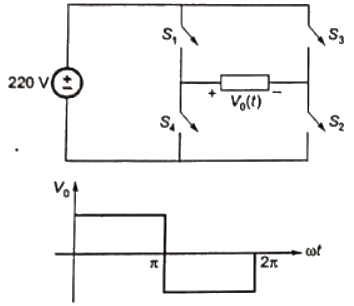

Q11: A 3-phase voltage source inverter is supplied from a 600V DC source as shown in the figure below. For a star connected resistive load of 20 Ω per phase, the load power for 120° device conduction, in kW is __________. (SET-1 (2017))
 (a) 18
(a) 18
(b) 9
(c) 245
(d) 90
Ans: (b)
Sol: 
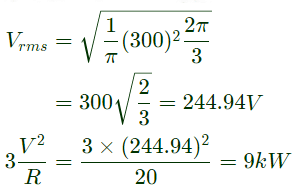
Q12: A three-phase Voltage Source Inverter (VSI) as shown in the figure is feeding a delta connected resistive load of 30 Ω/phase. If it is fed from a 600 V battery, with 180° conduction of solid-state devices, the power consumed by the load, in kW, is __________. (SET-2 (2016))
 (a) 10
(a) 10
(b) 20
(c) 24
(d) 30
Ans: (c)
Sol: 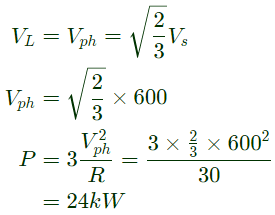
Q13: A single-phase full-bridge voltage source inverter (VSI) is fed from a 300 V battery. A pulse of 120° duration is used to trigger the appropriate devices in each half-cycle. The rms value of the fundamental component of the output voltage, in volts, is (SET-1 (2016))
(a) 234
(b) 245
(c) 300
(d) 331
Ans: (a)
Sol: 

Q14: The switches T1 and T2 in Figure (a) are switched in a complementary fashion with sinusoidal pulse width modulation technique. The modulating voltage vm(t) = 0.8sin(200πt) V and the triangular carrier voltage (vc) are as shown in Figure (b). The carrier frequency is 5 kHz. The peak value of the 100 Hz component of the load current (iL), in ampere, is ________ . (SET-1 (2016))
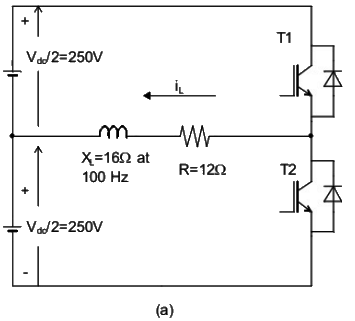
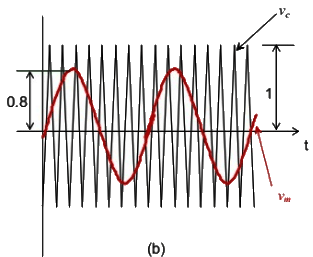 (a) 10
(a) 10
(b) 100
(c) 150
(d) 20
Ans: (a)
Sol: 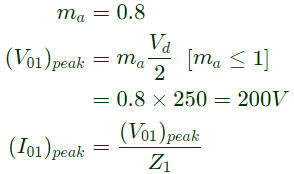

Q15: The single-phase full-bridge voltage source inverter (VSI), shown in figure, has an output frequency of 50 Hz. It uses unipolar pulse width modulation with switching frequency of 50 kHz and modulation index of 0.7. For Vin = 100 V DC, L = 9.55 mH, C = 63.66 μF, and R = 5 Ω, the amplitude of the fundamental component in the output voltage Vo (in Volt) under steady-state is ________. (SET-1 (2015))
 (a) 12.25
(a) 12.25
(b) 40.25
(c) 62.75
(d) 82.75
Ans: (c)
Sol: The rms value of the fundamental component of output voltage,
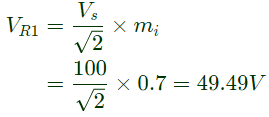 Amplitude of the value is peak value (i.e.)
Amplitude of the value is peak value (i.e.)
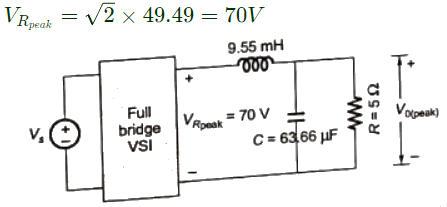
 is the amplitude of fundamental voltage at the VSI.
is the amplitude of fundamental voltage at the VSI.  is the amplitude of fundamental voltage at the resistor.
is the amplitude of fundamental voltage at the resistor.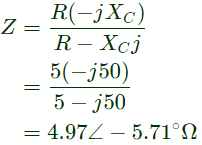 where,
where,
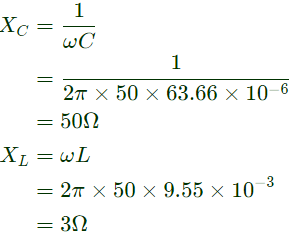
 Therefore, the amplitude of the fundamental component in the output voltage, V0 = 62.75V .
Therefore, the amplitude of the fundamental component in the output voltage, V0 = 62.75V .
Q16: A single-phase voltage source inverter shown in figure is feeding power to a load. The triggering pulses of the devices are also shown in the figure.
 If the load current is sinusoidal and is zero at 0, π, 2π.., the node voltage VAO has the waveform (SET-3 (2014))
If the load current is sinusoidal and is zero at 0, π, 2π.., the node voltage VAO has the waveform (SET-3 (2014))
(a)  (b)
(b) 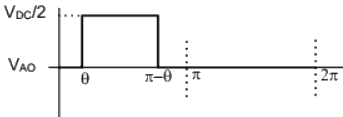 (c)
(c) 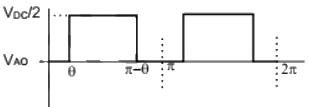 (d)
(d)  Ans: (d)
Ans: (d)
Sol: 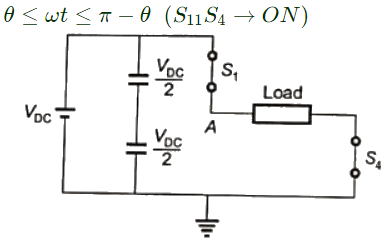

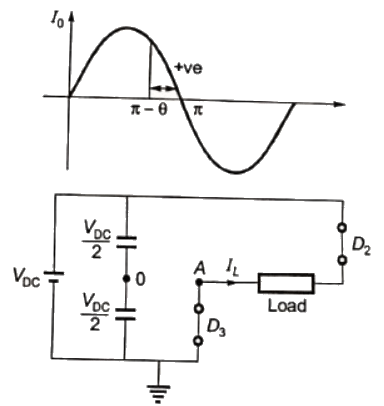
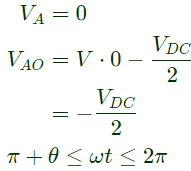
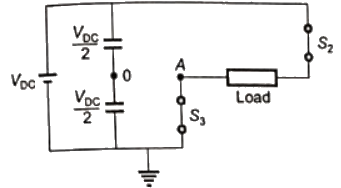

Q17: The figure shows one period of the output voltage of an inverter. α should be chosen such that 60° < α < 90°. If rms value of the fundamental component is 50V, then α in degree is _____. (SET-1 (2014))
 (a) 42.35
(a) 42.35
(b) 77.15
(c) 82.15
(d) 98.35
Ans: (b)
Sol: The output voltage V0 can be reprresnted by fourier series as under:
 where,
where,
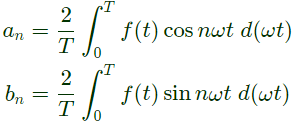
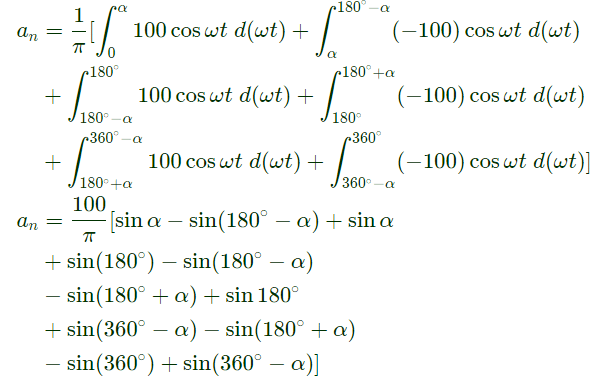
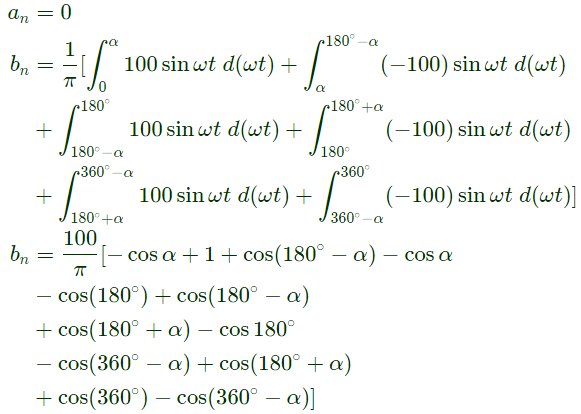

Q18: The Voltage Source Inverter (VSI) shown in the figure below is switched to provide a 50 Hz, square-wave ac output voltage (vo) across an R - L load. Reference polarity of vo and reference direction of the output current io are indicated in the figure. It is given that R = 3Ω, L = 55.9 mH. (2013)
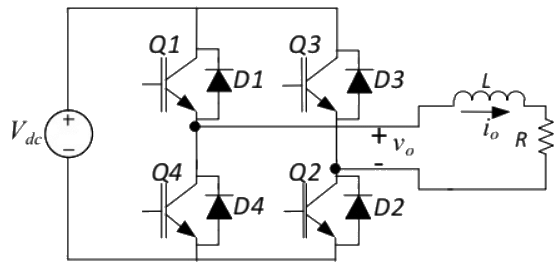 Appropriate transition i.e., Zero Voltage Switching (ZVS)/Zero Current Switching (ZCS) of the IGBTs during turn-on/turn-off is (2013)
Appropriate transition i.e., Zero Voltage Switching (ZVS)/Zero Current Switching (ZCS) of the IGBTs during turn-on/turn-off is (2013)
(a) ZVS during turn off
(b) ZVS during turn-on
(c) ZCS during turn off
(d) ZCS during turn-on
Ans: (d)
Q19: The Voltage Source Inverter (VSI) shown in the figure below is switched to provide a 50 Hz, square-wave ac output voltage (vo) across an R-L load. Reference polarity of vo and reference direction of the output current io are indicated in the figure. It is given that R = 3Ω, L = 55.9 mH.
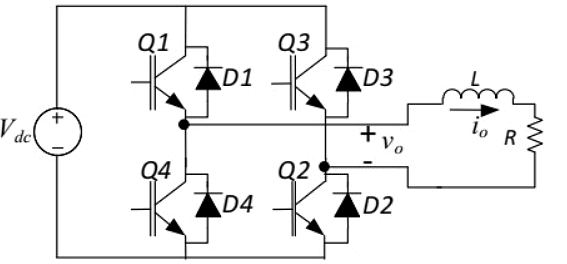 In the interval when vo < 0 and io > 0 the pair of devices which conducts the load current is (2013)
In the interval when vo < 0 and io > 0 the pair of devices which conducts the load current is (2013)
(a) Q1, Q2
(b) Q3, Q4
(c) D1, D2
(d) D3, D4
Ans: (d)
Sol: As V0 < 0, (Q3, D3) and (Q4, D4) should work.
Also P = v0i0
As I0 > 0
P < 0
Power is being feedback.
so D3 and D4 are working.
Q20: In the 3-phase inverter circuit shown, the load is balanced and the gating scheme is 180°-conduction mode. All the switching devices are ideal.
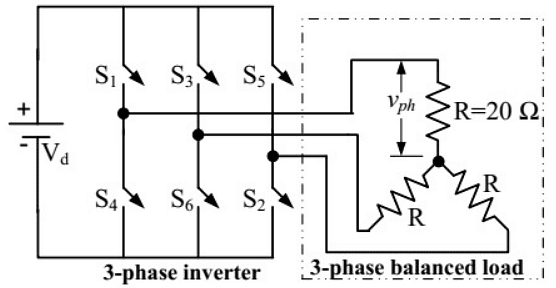 If the dc bus voltage Vd = 300 V, the power consumed by 3-phase load is (2012)
If the dc bus voltage Vd = 300 V, the power consumed by 3-phase load is (2012)
(a) 1.5kW
(b) 2.0kW
(c) 2.5kW
(d) 3.0kW
Ans: (d)
Sol: Power consumed by each resistor
 Total power consumed = 3P = 3kW
Total power consumed = 3P = 3kW
 (a) 11
(a) 11 Boost :
Boost :






 ∴ Peak to peak load current,
∴ Peak to peak load current,

 Alternate solution:
Alternate solution:
 Put the values
Put the values
 (a) 2154
(a) 2154 Now, Power output
Now, Power output
 (a) 51.1
(a) 51.1

 ∴
∴ 


 (a) 300√2
(a) 300√2






 (a) 220
(a) 220

 (a) 18
(a) 18

 (a) 10
(a) 10



 (a) 10
(a) 10

 (a) 12.25
(a) 12.25 Amplitude of the value is peak value (i.e.)
Amplitude of the value is peak value (i.e.)
 is the amplitude of fundamental voltage at the VSI.
is the amplitude of fundamental voltage at the VSI.  is the amplitude of fundamental voltage at the resistor.
is the amplitude of fundamental voltage at the resistor. where,
where,
 Therefore, the amplitude of the fundamental component in the output voltage, V0 = 62.75V .
Therefore, the amplitude of the fundamental component in the output voltage, V0 = 62.75V . If the load current is sinusoidal and is zero at 0, π, 2π.., the node voltage VAO has the waveform (SET-3 (2014))
If the load current is sinusoidal and is zero at 0, π, 2π.., the node voltage VAO has the waveform (SET-3 (2014)) (b)
(b)  (c)
(c)  (d)
(d)  Ans: (d)
Ans: (d)





 (a) 42.35
(a) 42.35 where,
where,



 Appropriate transition i.e., Zero Voltage Switching (ZVS)/Zero Current Switching (ZCS) of the IGBTs during turn-on/turn-off is (2013)
Appropriate transition i.e., Zero Voltage Switching (ZVS)/Zero Current Switching (ZCS) of the IGBTs during turn-on/turn-off is (2013) In the interval when vo < 0 and io > 0 the pair of devices which conducts the load current is (2013)
In the interval when vo < 0 and io > 0 the pair of devices which conducts the load current is (2013) If the dc bus voltage Vd = 300 V, the power consumed by 3-phase load is (2012)
If the dc bus voltage Vd = 300 V, the power consumed by 3-phase load is (2012) Total power consumed = 3P = 3kW
Total power consumed = 3P = 3kW




















